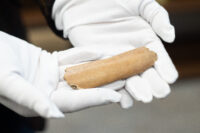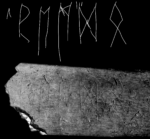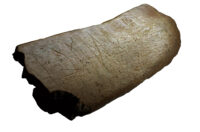 A bovine rib bone inscribed in Elder Futhark runes is the oldest writing system ever used by ancient Slavs. It is also the first archaeological evidence of direct contact between the Germanic tribes of Central Europe and the Early Slavs.
A bovine rib bone inscribed in Elder Futhark runes is the oldest writing system ever used by ancient Slavs. It is also the first archaeological evidence of direct contact between the Germanic tribes of Central Europe and the Early Slavs.
The bone was discovered in Břeclav-Lány, South Moravia, Czech Republic, in a 2017 excavation of an Early Slavic settlement occuped from the 6th-7th century to the 9th. It was in a pit with other animal bones, handmade pottery and clay pans. Radiocarbon analysis of the inner section of the bone dates it to between 585-640 A.D. The date range makes this pit the earliest absolute dated Early Slavic feature in the Czech Republic and Austria.
 The inscription consists of six of the last eight runes of Elder Futhark. The vast majority of the 430 extant examples of Elder Futhark are personal names. Only 17 of them are abecedaries, whole or partial, and this is the only one with the final part of the runic alphabet; the others are missing the last three runes. It is also the first one found in a non-Germanic archaeological context.
The inscription consists of six of the last eight runes of Elder Futhark. The vast majority of the 430 extant examples of Elder Futhark are personal names. Only 17 of them are abecedaries, whole or partial, and this is the only one with the final part of the runic alphabet; the others are missing the last three runes. It is also the first one found in a non-Germanic archaeological context.
Archaeologists believe that bone originally contained the entire alphabet but only the broken end of it has survived. Because it’s an abecedary rather than a word, it’s likely the bone was used as a teaching tool. The carver appears to have been inexperienced. In addition to the missing runes l and ŋ, there are errors of proportion and extra lines from repeated attempts at a rune.
 Before this discovery, the earliest script encountered by the Slavic people was believed to be Glagolitic, an alphabet invented in the 9th century A.D. by Saints Cyril and Methodius of Byzantium to translate the Gospels into Slavic languages. The rune bone indicates that Slavs encountered a form of writing almost 300 years earlier than previously believed.
Before this discovery, the earliest script encountered by the Slavic people was believed to be Glagolitic, an alphabet invented in the 9th century A.D. by Saints Cyril and Methodius of Byzantium to translate the Gospels into Slavic languages. The rune bone indicates that Slavs encountered a form of writing almost 300 years earlier than previously believed.
This ground-breaking discovery made by archaeologists from Masaryk University demonstrates that before the introduction of the Glagolitic script the Slavs had come into contact with runes, which they may have used for counting or divination, for example. This finding also calls into question whether cultural differences between Germanic and Slavic Europe were so clear cut. “The fact that it is the earliest evidence of writing among Slavs is certainly interesting for the nearly 300 million people who speak Slavic languages,” added Macháček.
The study has been published in the Journal of Archaeological Science and can be read here.